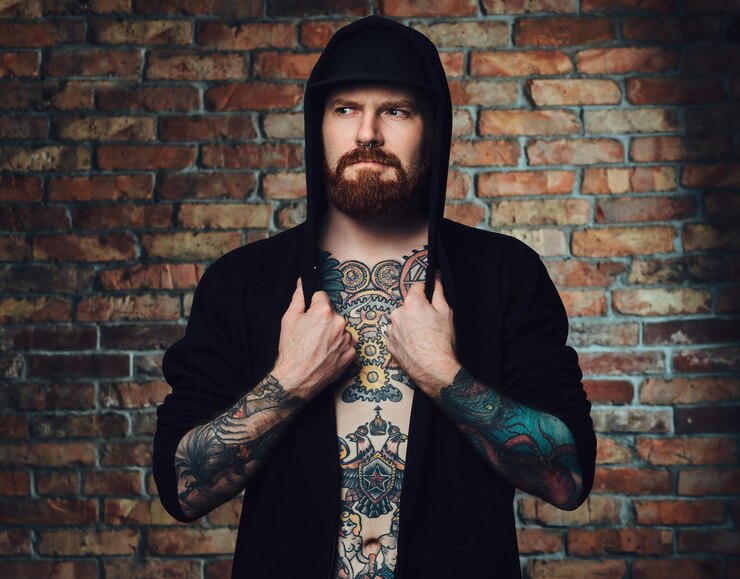The allure of Viking tattoos has captured the imagination of many, blending ancient history with contemporary style. Whether you’re a tattoo enthusiast or a history buff, the fascination with these intricate designs and their profound meanings is undeniable. In this blog post, we will explore the rise of Viking tattoos, decode their symbols, examine contemporary tattoo art, and hear personal stories from those who proudly wear them.
The Rise of Viking Tattoos and Their Modern Popularity
The popularity of Viking tattoos in modern times is a testament to their enduring appeal. From their origins in Norse mythology to their resurgence in contemporary culture, Viking tattoos have a rich and fascinating history.
Centuries ago, the Vikings were known for their fierce warriors and deep mythological beliefs. Their tattoos often depicted symbols of power, protection, and their gods and goddesses. Today, these same symbols are being embraced by individuals seeking to connect with their inner strength and heritage.
The resurgence of Viking tattoos in contemporary culture can be attributed to the increased interest in Norse mythology, driven by popular media such as TV shows, movies, and books. This renewed fascination has led to a revival of traditional Viking symbols in tattoo art, blending ancient mystique with modern artistry.
The Meaning Behind Viking Symbols
Runes and Their Significance
Runes are among the most iconic Viking symbols, each with its own unique meaning. The Futhark, or runic alphabet, was used for both practical and magical purposes.
- Dagaz symbolizes transformation and the natural cycle of day and night. It represents maturity and personal growth, making it a popular choice for those embarking on new journeys.
- Inguz is associated with fertility and new beginnings. This rune is often chosen by individuals starting new projects or chapters in their lives.
- Laguz represents water and the flow of emotions. It is a symbol of intuition, life, and renewal, perfect for those seeking balance and harmony.
- Othila stands for heritage and family. It signifies lasting prosperity and good fortune, embodying the value of legacy.
- Berkana is linked to femininity, motherhood, and fertility. This rune is especially meaningful for women celebrating their strength and nurturing qualities.
Thor’s Hammer (Mjölnir)
Thor’s hammer, Mjölnir, is one of the most powerful symbols in Viking mythology. Representing protection, power, and bravery, Mjölnir was believed to protect its wearer from harm. This symbol is frequently chosen by those who wish to embody strength and resilience.
Valknut and Its Warrior Spirit
The Valknut, also known as the heart of the fallen or Odin’s knot, is composed of three interlocking triangles. It symbolizes the warrior’s dedication to Odin, the supreme Norse god. This tattoo represents courage, valor, and the readiness to face any challenge, making it a favorite among fighters and those who admire Viking bravery.
Vegvísir – The Viking Compass
The Vegvísir, or Viking compass, is an ancient Icelandic symbol meant to guide its bearer through rough weather. It stands for finding one’s way and staying true to one’s path. This symbol is perfect for those seeking direction and purpose in life.
The Art of Viking Tattooing
Unique Styles and Techniques
Viking-inspired tattoos boast unique styles and techniques that set them apart. The intricate details and bold lines are characteristic of these tattoos, often incorporating elements of traditional Norse art.
Intricate Designs and Skilled Artists
Viking tattoos require a high level of skill and expertise. Artists specializing in this style need to understand the historical significance and cultural context of each symbol. The results are breathtaking designs that capture the essence of Viking heritage.
Showcasing Masterpieces of Viking Tattoo Art
Skilled tattoo artists around the world have embraced Viking motifs, creating stunning works of body art. These masterpieces blend ancient symbolism with modern tattooing techniques, resulting in visually striking and deeply meaningful pieces.
Personal Stories and Testimonials

Real Stories from Viking Tattoo Bearers
Individuals who choose Viking tattoos often have personal stories that connect them to these ancient symbols. Their tattoos serve as reminders of their heritage, personal growth, and the values they hold dear.
The Personal Significance of Viking Tattoos
For many, Viking tattoos are more than just body art—they are a representation of their identity and beliefs. These tattoos carry personal significance, reflecting the wearer’s journey, strength, and connection to Norse mythology.
Experiences and Reflections
Tattoo bearers often share their experiences and reflections on what their Viking tattoos mean to them. These stories highlight the emotional and spiritual connections that these symbols evoke, adding depth to the art form.
Viking Tattoos in Pop Culture
Portrayal in Movies and TV Shows
Viking tattoos have made their mark in pop culture, particularly in movies and TV shows. Popular series like “Vikings” and “The Last Kingdom” showcase these tattoos, sparking interest and inspiring viewers to explore Viking history and mythology.
Influence on Contemporary Tattoo Trends
The depiction of Viking tattoos in media has significantly influenced contemporary tattoo trends. More people are seeking out these ancient symbols, drawn by their powerful meanings and striking designs.
The Impact of Pop Culture on Viking Tattoo Popularity
Pop culture continues to play a crucial role in the popularity of Viking tattoos. The fascination with Norse mythology and the portrayal of Viking warriors in media have cemented these tattoos’ place in modern tattoo culture.
Conclusion
The enduring appeal of Viking tattoos lies in their rich history, profound meanings, and striking designs. Whether you are drawn to the symbolism of runes, the power of Thor’s hammer, or the guidance of the Vegvísir, these tattoos offer a unique way to connect with ancient heritage and personal strength.